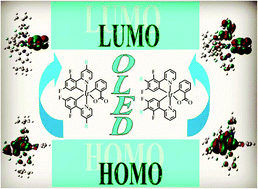Tuning the electronic and phosphorescence properties of blue-emitting iridium(iii) complexes through different cyclometalated ligand substituents: a theoretical investigation†
Abstract
The geometric and electronic structures, phosphorescence properties and the organic light-emitting diode (OLED) performance of a series of Ir(III) complexes based on bis[(4,6-di-fluorophenyl)-pyridinato-N,C2′]picolinate (FIrpic) were investigated by using density functional theory/time-dependent density functional theory (DFT/TD-DFT), including Ir(III)bis[2-(2,4-difluorophenyl)-4-(tert-butyl)pyridinato-N,C2′]picolinate (1a), Ir(III)bis[2-(2,4-difluorophenyl)-4-(n-heptyl)pyridinato-N,C2′]picolinate (2a), Ir(III)bis[2-(2,4-difluorophenyl)-4-(3-ethylheptyl)pyridinato-N,C2′]picolinate (3a), Ir(III)bis[2-(2,4-difluorophenyl)-4-(2,4,6-trimethylphenyl)pyridinato-N,C2′]picolinate (5a), and Ir(III)bis[2-(2,4-difluoro-3-(2,4,6-trimethylphenyl)phenyl)-pyridinato-N,C2′] picolinate (5b). To explore the influence of the substituted positions on the optical and electronic properties of the Ir(III) complexes, seven other new complexes were designed by introducing the substituted groups on the difluorophenyl rings or pyridine rings. After introducing the phenyl substituted groups on the pyridine or difluorophenyl rings of cyclometalated ligands, the HOMO–LUMO energy gap is decreased. Thus, the absorption spectra of 4a and 4b undergo a red-shifting, especially for 4a, and have a stronger absorption strength that will be beneficial to improving their quantum yields, which is proved by the further evaluation of the radiative (kr) and non-radiative (knr) rate constants. The combinations of a larger 3MLCT-3MC energy gap, smaller ΔES1–T1, and higher contribution of 3MLCT in the emission process result in the higher quantum yields for complexes 4a and 4b. Besides, the designed complexes 4a and 4b are considered to be potential candidates as blue-emitting materials with better equilibrium between the hole transport (λhole) and electron transport (λelectron).

- This article is part of the themed collection: Luminescent Complexes and Materials for Light-Emitting Devices

 Please wait while we load your content...
Please wait while we load your content...